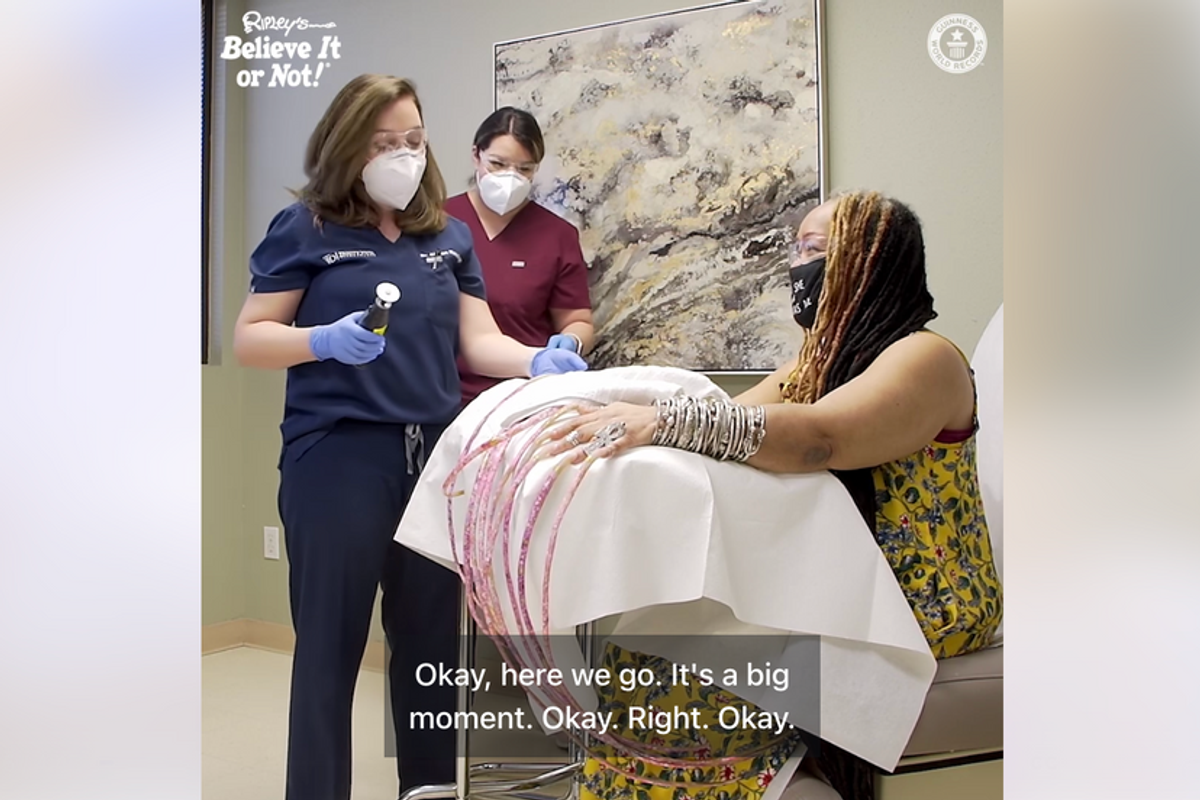People can't look away as woman with world's longest fingernails finally gets them trimmed
30 years of growth. Gone just like that.
We just can't help ourselves:There's something about seeing something out of the ordinary, be it a strange animal, an accident or even an argument between strangers. Humans are naturally curious beings and seeing a random argument between your neighbor and her teenage son will have some people outside taking their goldfish for a walk just to gawk.
So it's not surprising that thousands of viewers tuned in when Ayanna Williams, the Guinness World Record holder for the world's longest nails went to have them all cut off. Williams had her record breaking nails for 29 years but decided it was finally time to bid them adieu and the entire thing was filmed. It's a monumental moment for the record holder after having lived with the 24 foot nails for decades.
(If 24 feet sounds absolutely outrageous for fingernails, it is! But keep in mind that Guinness tallies the total length of all ten finger nails, making each of Williams' nails an average of 2.4 feet long.)
Most of us would simply need to grab a pair of fingernail clippers and get clipping, but for Williams the process was a bit more complicated.
The record holder couldn't just head to her nearest nail salon for a fresh manicure, although she did treat her nails to one last pampering first. The manicure took more than three whole bottles of polish and took several days to complete. For reference, a manicure for a normal set of nails takes about 30 minutes.

Then she had to have her nails trimmed by a professional: Dr. Allison Readinger at Trinity Vista Dermatology, where the dermatologist used a special hand held circular saw. Williams disclosed the two foot nails were causing her joint pain and one of her thumbs was extremely tender so she was relieved to lose the weight of the nails. The nails are now on display at Ripley's Believe it or Not! Museum in Orlando, Florida.
Viewers couldn't look away from this re-shared video of Williams said goodbye to her long nails. Some comments were supportive while others...not so much.
"I’m so happy she was able to finally make this decision! I love it," one person writes.
"Wooww! It's a incredible it's been a 29 yrs," another says.
"Oh gosh so satisfying. Can't even have mine passed my finger tips. Ouf," someone exclaims.
According to Guinness World Records, Williams went through over two bottles of nail polish and gave up 20 hours of her time with every nail polish change. If nothing else, cutting her nails will be a money saver and whether you support her nail growth or not, there's something satisfying about watching them be cut off.
Watch the captivating video below:
So what of Williams' throne and title?
It now belongs to a woman named Diana Armstrong, who owns astonishing 42 foot long fingernails. You may have seen people in the news with fingernails that seem much longer, but those people often only grow the nails on one hand — halving their chances at becoming the world champ!
Diana was crowed in April of 2024.
Going for a World Record in fingernails is an extremely taxing undertaking. The nails begin to dominate your entire life, with Williams even admitting she couldn't do many daily tasks like washing dishes or changing her sheets without assistance. Not to mention all the pain and discomfort they caused her. Plus there's the upkeep, which involves rigorous cleaning that takes hours, moisturizing, and more. The question on everyone's mind, of course, is how do people with the longest nails in the world wipe after they go to the bathroom? Alas, for now it remains a trade secret, but some theorize people gunning for the world prize in nails may use wiping devices similar to the ones used by obese folks who have similar mobility troubles.
In any case, Williams was glad to retire on top, but also glad to be free of the huge burden of maintaining her hefty nails. She looks forward to seeing the next World Record holders crowned.
This article originally appeared two years ago. It has been updated.

